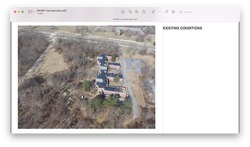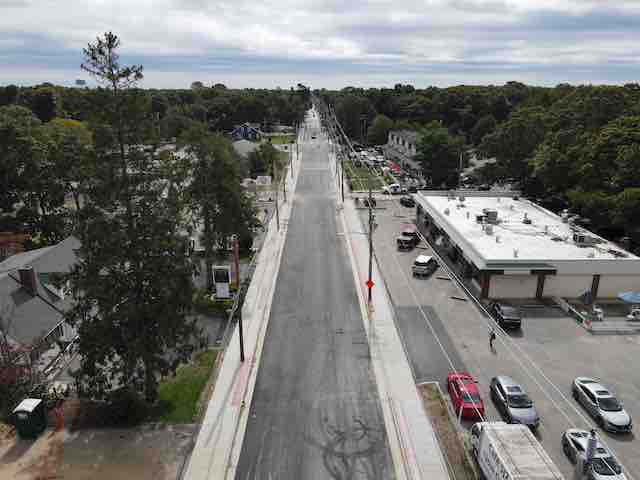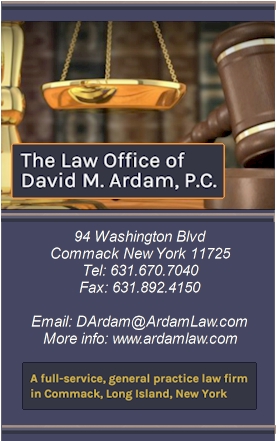Town Historian Bradley Harris On Smithtown's Founder Richard Smythe
 Monday, January 13, 2014 at 12:18AM
Monday, January 13, 2014 at 12:18AM By Smithtow Town Historian Bradley Harris
Richard Smythe, the founder and patentee of Smithtown, remains an elusive historical figure….
 “Whisper” is a constant reminder to Smithtown residents of the story of the origin of the town founded by Richard Smythe. The bull is part of the legend that surrounds Richard Smythe, and much about Richard Smythe is legendary. Richard Smythe, the man, the “Bull Rider,” remains an elusive historical figure. There is much that we know about the man, but there is a great deal that we don’t know. While certain things are known, such as the existence of the Nicholls Patent, issued on March 3, 1665 by the Royal Governor of the Colony of New York, that recognized Richard Smythe’s claim of possession of the lands of the Nesaquauke, we don’t know how Smythe managed to convince the English Royal Governor to issue a Patent in his name and give Smith such a large proprietary land grant. There are a host of other questions for which we have no answer. The facts of his birth are not really known, and his parentage, background and education are only guessed at. We don’t know why Richard Smith came to America, where he settled in the Boston area, how he met his wife, what her maiden name was, and when and where they were married. We’re not sure where his home was located in Nissequogue, and we have only a suspicion that he was buried on Whisper Hill. We don’t even know whether he owned a bull. But we have the “bull story” and that provides one explanation for how he acquired the Nesaquake lands.
“Whisper” is a constant reminder to Smithtown residents of the story of the origin of the town founded by Richard Smythe. The bull is part of the legend that surrounds Richard Smythe, and much about Richard Smythe is legendary. Richard Smythe, the man, the “Bull Rider,” remains an elusive historical figure. There is much that we know about the man, but there is a great deal that we don’t know. While certain things are known, such as the existence of the Nicholls Patent, issued on March 3, 1665 by the Royal Governor of the Colony of New York, that recognized Richard Smythe’s claim of possession of the lands of the Nesaquauke, we don’t know how Smythe managed to convince the English Royal Governor to issue a Patent in his name and give Smith such a large proprietary land grant. There are a host of other questions for which we have no answer. The facts of his birth are not really known, and his parentage, background and education are only guessed at. We don’t know why Richard Smith came to America, where he settled in the Boston area, how he met his wife, what her maiden name was, and when and where they were married. We’re not sure where his home was located in Nissequogue, and we have only a suspicion that he was buried on Whisper Hill. We don’t even know whether he owned a bull. But we have the “bull story” and that provides one explanation for how he acquired the Nesaquake lands.
We all know the bull story. Even so, you might be interested in what John Lawrence Smith wrote in his History of Smithtown, published in 1883: “Richard Smythe and his descendants are habitually alluded to, by the inhabitants, as the ‘Bull-Rider’ and the ‘Bull Smiths.’ Tradition says that he purchased of the Indians as much land as he could ride around on a bull in a day, and having a trained bull which he used as a horse, he started early, reached the valley between Smithtown and Huntington at noon, rested and took his lunch (thereby giving the valley the name of Bread and Cheese hollow; which it still retains), and completed the whole circuit of the township by nightfall – much to the astonishment of the natives.” “It seems a pity to spoil this old legend, but the quiet manner in which Richard Smythe acquired from Gardiner his title to the whole territory, and the great trouble he had afterward with his neighbors in settling his boundary, render it quite certain that the tradition about his sharp bargain with the Indians is partly drawn from the classic story of Dido’s purchase of the site of Carthage, partly a flight of the imagination, and wholly untrue. It is possible that the patentee did ride a bull. Bulls in later days often supplied the place of horses,” but “the patentee was in easy circumstances” and “he had plenty of” horses “when the tax-gatherer first came to his settlement,” so why ride a bull? So there you have it, straight from the Judge’s mouth so to speak – the bull story is just that – bull.
So how, if he didn’t acquire the Nesaquake lands through a bull-ride, how did he acquire the land? Richard Smythe first came to America aboard the ship known as the John of London that sailed from England for St. Christopher’s in the Caribbean West Indies on October 2, 1635. Why he chose to emigrate to America at this time is not known, but he was travelling with 33 other passengers, all single young men and women. The passenger manifest lists six women, ages 18-21, and 27 men ranging in age from 18-28, one Richard Smith, age 22, among them. It almost appears to have been a “singles cruise.” Ships sailing for the West Indies followed a course that took them along the New England coast and it would have stopped at Boston along the way. Richard Smythe could have ended his voyage in Boston or perhaps gone on to St. Christopher’s and then come back to Boston at a later date. Where he was living and what he was doing at this time in his life is not known. The first definitive mention we have of Richard Smythe appears in the town records of Southampton, L.I., dated October 26, 1643. The entry concerns a ruling of the Southampton General Court and directs a Thomas Hyldreth to settle a dispute he was having with “Mr. Smith” by paying him “three pounds and twelve shillings and foure pence” worth of English wheate to settle “all matters of Controversie” that had arisen between them. It sounds as if Thomas Hyldreth had somehow damaged Mr. Smith’s wheat crop.
Southampton was first settled in 1639/40 by a group of men living at Lynn in the Massachuetts Bay Colony who crossed the Sound and settled Southampton on L.I.’s south fork.. Richard Smythe was not one of the original proprietors of the town, but obviously had joined them by 1643 when he got into a dispute with Thomas Hyldreth. By 1648, Richard was chosen “freeman” of the town, and in 1649, he is listed as a freeman and head of a family.
Richard’s wife Sarah has always been a bit of a mystery. The Smith family biographer, Dr. Frederick Kinsman Smith who compiled the book The Family of Richard Smith that covers ten generations of Richard Smith’s descendants, believes that Richard Smith found his wife in New England. Sarah Folger was thought to have been the woman he married. But family historians today (Ned Smith and Henry Hoff) now suspect his wife was Sarah Hammond of Watertown, Massachusetts. Now we know what Richard Smythe was doing in the Boston area from 1635-1640, he was looking for a wife. Sarah Hammond, born in 1623, in Lavenham, Suffolk, England, was 17 or 18, 10 years younger than Richard Smythe when they married in 1640. Since they had their first child, a boy named Jonathan in 1641, it seems likely they were married before they settled in Southampton. But we have no record of their marriage. All we know is that Richard and Sarah had seven sons and two daughters, and five of their children were born while the Smythes lived in Southampton.
Richard Smythe seems to have been a leader in Southampton. His home lot was one of the larger lots in town, made up of three 50 pound lots, suggesting that he made a considerable investment in buying into Southampton. Out of 50 proprietors, about ¼ had two 50 pound lots, another ¼ had three 50 pound lots, and most of the rest had one fifty pound lot. Richard Smythe’s home lot was at the north end of Main Street, near the Pond and not far from the ocean. He had a full proprietor’s right in the settlement and was chosen freeman of the town, and thus became a member of the General Court and eligible to any office. He served as a member of a committee to regulate the laying out of the land on the “Great Playnes” and by vote of the General Court he was elected to the office of constable. He served as one of the two town assessors, served on a jury of 12 men in an action for slander, and was chosen to serve on a committee that was given the responsibility of cutting up whales that washed up on the beach.
Richard Smythe’s entire career in Southampton shows him to have been a man of active enterprise, foremost among his equals and of the same rank as Edward Howell, Lion Gardiner and Richard Woodhull, the three famed leaders of Long Island settlements. He had been a leader and highly respected member of his community for 13years when the following entry makes its appearance in the Southampton records on September 17, 1656: “It is ordered by the General Court that Richard Smith for his unreverend carriage towards the magristrates contrary to the order was adjudged to be banished out of the towne and hee is to have a week’s liberty to prepare himself to depart, and if at any time hee be found after this limited week within the towne or the bounds thereof he shall forfeit twenty shillings.”
Banishment! What heinous crime had Richard Smythe committed what resulted in a punishment of such severity? Unfortunately the only further mention of Richard Smythe in the town records appears under the date of October 6, 1656, when Richard Smythe was fined “the sum of five pounds” apparently because he was still in Southampton. There is no explanation as to why he was banished. Dr. Frederick Kinsman Smith seems to have found a plausible answer for this banishment.
Dr. Smith believed that Richard Smythe returned to England for a visit sometime in 1655 when he was 42. Why he chose to make this visit is not known. Perhaps he wanted to see his aging parents to try to persuade them to join him in America. According to Ancestors.com, both of his parents did eventually emigrate to America. His father, Richard Smith, born in Leicestershire in England in 1589, died in Wethersfield, Hartford, Connecticut in 1667. His mother, Joan Barton, born in Gloucestershire, England in 1599, died in Narragansett, Washington, Rhode Island in 1664. Whatever the reason for returning to England, his visit put Richard Smythe in England ready to return to Boston aboard the ship Speedwell when it sailed from Gravesend, England on May 30, 1656. Among the 41 passengers was a “Richard Smythe aged 43 years.” Also among the passengers were eight people “designated as Quakers.” Dr. Smith believed that Richard Smythe was “in close association” with these Quakers on the ten week voyage to America and that he adopted their views “after prolonged thought and discussion on the voyage.” When the Speedwell arrived at Boston on August 7, 1656, the eight Quakers were seized and imprisoned along with Richard Smythe. Richard was apparently interrogated and detained for three weeks, and then sent home to his family at Southampton, L.I., where he arrived in September of 1656, only to be banished from Southampton for his “unreverend carriage toward the magistrates.” Dr. Kinsman Smith felt that Richard Smythe got into difficulty with the Southampton magistrates and people because of the ardor that must have led to “new convert” to actively “disseminate his newly acquired convictions and to confer upon others the satisfaction and pleasure that he himself had found in them.” This activity would certainly have led his Puritan neighbors to the act of banishment. Dr. Smith also felt that this incident explains why Richard Smythe acquired the nickname of “Quaker Smith.”
(If this is truly the explanation for Richard Smythe’s banishment from Southampton, it is interesting to note that in the spring of 1657, Richard Smythe would have been the only Quaker in America since the Boston magistrates sent the other Quakers back to England and it was not until “the summer of 1657 that a “number of Quakers came.”)
Banished from Southampton, Richard Smythe sought refuge in Setauket among other friends that he had known in Southampton. He would reside in Setauket for another nine years, from 1656 to 1665. During this time he secured title to the lands that make up Smithtown from the Nesaquake Indians and from Englishman who also claimed this area.
When Richard Smythe “first conceived of the idea of acquiring the Nissequogue lands” is not known. But it was his residence in Setauket that gave him firsthand knowledge of the Nissequogue River valley and this started him thinking about obtaining these lands for himself. A fortuitous set of cirumstances was to give him the opportunity to change his dreams into reality.
The lands that Richard Smythe coveted were owned by the Nesaquake Indians “who dwelt on both sides of the Nissequogue River.” The Nesaquake tribe was in turn dominated by the largest tribe of Indians on Long Island, the Montauk Indians. The chief or sachem of the Montauks was Wyandanch who was recognized as the “acknowledged ruler of all other sachems on the east end of Long Island.” All the smaller tribes paid tribute to him, and it was generally understood that no conveyance of land was valid without his concurrence. In many instances he held title to the lands by gift or purchase from the subordinate chief, and conveyed those lands to the whites in his own name.” In 1659, Wyandanch conveyed the Nesaquake lands to Lion Gardiner. Why he chose to do this is interesting.
“Lion Gardiner, patentee of Gardiner’s Island,” and the first white man who settled on the east end of Long Island in 1639, had been a friend to Wyandanch and the Montauks and had served as a “counselor in all their troubles.” One of the troubles that the Montauk tribe encountered happened in 1653 when Narragansett Indians paddled across Long Island Sound in their war canoes to attack the tribe. Their attack came on the night when Wyandanch’s only daughter, Momone, was to be married to a Shinnecock sachem. The Montauks were hosting the marriage celebration and feast for the Shinnecock tribe on Montauk Point when the savage Narragansett Indians struck. In the ensuing battle, half the Montauk tribe was annihilated and Wyandanch’s daughter, Princess Momone, “the Heather Flower,” was kidnapped. (No one knows how many Montauks and Shinnecock Indians were killed that night. The Montauks were thought to have had over 2,000 people at the time of contact with Europeans, so the battle brought the loss of over a 1000 Montauks. We know that this encounter took place in Massacre Valley on the east side of Lake Montauk.)
In the aftermath of this bloody encounter, Wyandanch sought Lion Gardiner’s help in getting his daughter returned to him from the Narragansett Indians. Lion Gardiner appealed to the leaders of the Massachuetts Bay Colony “to pressure the Narragansetts into returning Princess Momone” and they did so. The Narragansett sachem “Ninigret” agreed to ransom the Heather Flower “for a huge pile of wampum.” Lion Gardiner helped Wyandanch gather the required wampum. The ransom was “sent to Ninigret in Montauk war canoes” only to be “intercepted by agents of John Wintrop, governor of the Connecticutt colonies.” Again Wyandanch appealed to lion Gardiner to intercede on his behalf and Lion “intervened with Winthrop” who saw to it that the wampum was delivered to Ninigret. The Heather Flower was finally released by Ninigret and “tradition has it that the restoration of Wyandanch’s daughter to her father” took place at “Richard Smythe’s residence at Setauket.” A grateful father and sachem then wanted to give to Lion Gardiner a token of his esteem and friendship; and in a very interesting deed, dated at East Hampton on July 14, 1659, several years after the Heather Flower’s rescue, Wyandanch conveyed the Nesaquake lands to Lion Gardiner. What is suspicious is that Richard Smythe witnessed the deed, and four years later in 1663, Lion Gardiner conveyed these very same lands to Richard Smythe.
(The question that arises is whether Richard Smythe’s interest in the Nesaquake lands was awakened by his witnessing the signing of the deed or whether “he may have had something to do with bringing about the transaction” in the first place. William Pelletreau felt that there was “little doubt that the whole affair had been prearranged between Gardiner and Smythe.” So it appears that Richard Smythe may have been the instigator of the famous “deed of friendship” between Wyandanch and Lion Gardiner” and that his interest in the whole affair was to gain title to the Nesaquake lands from Lion Gardiner. We’ll never know what agreement was struck between Gardiner and Smythe because the deed ceding the lands from Gardiner to Smythe has been lost. All we have are some releases from David Gardiner indicating that Richard Smythe paid in full whatever he was supposed to pay for the Nesaquake lands and there was no outstanding debt. Show the “Friendship Deed” and Gardiner’s release from any other debt.)
When the lands were conveyed to Richard Smythe by Lion Gardiner in 1663, Richard Smythe set about securing undisputed possession of the land. This would take him the next 14 years of his life. He immediately sought out the surviving Nesaquake chieftains who could possibly claim ownership to the lands on the east and west banks of the Nissequogue River, and in separate deeds got them to cede ownership. Then sometime in 1664, Richard Smythe brought his family from Setauket to a little hollow on the eastern bank of the Nissequogue River where River Road and Moriches Road intersect in today’s Village of Nissequogue. Richard Smythe had carefully chosen this spot to build a new home in the Nesaquake lands. The hollow was close enough to the river to allow easy access by water, yet far enough inland to be sheltered from winter winds and storms. There was a fresh water spring and pond in the hollow and there were open fields that had been cleared by earlier Indian inhabitants. There were also Indian trails that led to this site that likely was the location of a former Indian village. It was in this hollow that the settlement of Smithtown began.
When Richard Smythe made this trek into the wilderness to stake his claim to the land that became Smithtown, he gave up an established home and lands in the close-knit community of Setauket although he retained possession of his Setauket holdings until 1686. By relocating his family to the “Nesaquauke” land that he acquired through negotiation and purchase, Richard Smythe established actual possession of the land. His possession of the “Nesaquauke” lands was confirmed on March 3, 1665, when the Royal Governor of the Colony of New York, Sir Richard Nicolls, granted him a patent. This Nicolls Patent recognized his ownership of the lands on the eastern bank of the river and acknowledged his disputed claim to the lands on the western bank. The Patent required that Richard Smythe settle ten families upon the land within three years, unless he was able to resolve the dispute he was having with Huntington over possession of the lands on the western bank, then he was required to settle twenty families upon the land within five years. To encourage Richard Smythe to settle families upon the land, the Royal Governor declared that Richard Smythe’s lands shall have the “like and equal priviledges” as any other town in the Colony, and that his lands would be exempt from paying taxes during the three (or five) years while he established families on the land. (An early tax abatement plan.)
In effect, the Patent created Smythe’s Town or Smithtown. But it took Richard Smythe another 12 years of contentious legal battling with the Town of Huntington before he prevailed in colonial courts and was granted the lands on the west bank of the Nissequogue River. Then a second patent granted in 1677 by the Royal Governor of the Colony of New York, Edmond Andros, reaffirmed Richard Smythe’s ownership of the Nesaquake lands on both sides of the river, and acknowledged that the lands owned by Richard Smythe were to be called Smithtown and were to be treated as a “township.”
During Richard Smythe’s lifetime, it was in fact Smythe’s Town. During the course of his life, he ruled over his domain as a father over his children, because many of the people who settled in his town were children, grandchildren, and great-grandchildren. As the family patriarch, he doled out the land to his kin and gave them property to settle and call their own. But the lands he owned were so extensive, that it was not until 1736, 44 years after his death, that his grandsons and granddaughters determined how to divide the lands of Smithtown. There was so much land to settle that the Smiths all tended to remain in the community, and as a result, there are thousands of Smith family descendants living in Smithtown today. It is always said of Smithtown, and this was true until the 20th century, that you could be walking down the streets of any hamlet in Smithtown and encounter a man or woman and you could greet them by saying: “Good morning Mr. Smith, or Good Morning Mrs. Smith!” and you were always right. It was and still is the town of Richard Smythe’s descendants.
Richard Smythe left us other objects of the past to venerate besides his descendants. There is his signature, spelled with a “y” instead of an “I”, his seal and cost of arms which is now the seal of Smithtown, his snuffbox, his sword, his chair, his pottery jug, and even what may be his original house, or at least part of his first home. This tiny wing of a house in Nissequogue (the former Meserve home off Long Beach road) is thought to have been part of his original dwelling. When he died in 1692, Richard Smythe carefully provided for his family’s future by writing many carefully detailed wills that subdivided much of his vast holdings among his many sons and daughters, giving away such things as his clothing, and gun, and slaves, and lands. But this careful man never provided for a tombstone, at least we don’t know where it is or where he might be buried. All we have today is this memorial stone on Whisper Hill indicating that he lived and died and his bones rest in peace, we hope! Apparently for all his attempts to resolve conflicts among his many progeny, it didn’t work because he was barely in his grave when his second son Richard took his mother to probate court over his inheritance.






Reader Comments (1)
I have a question. While driving down Moriches Road there seems to be an old estate at 91 Moriches and goes down to like 236 Moriches. What is the history of this location? There seems to be a handfull of houses on the location also.
Thanks